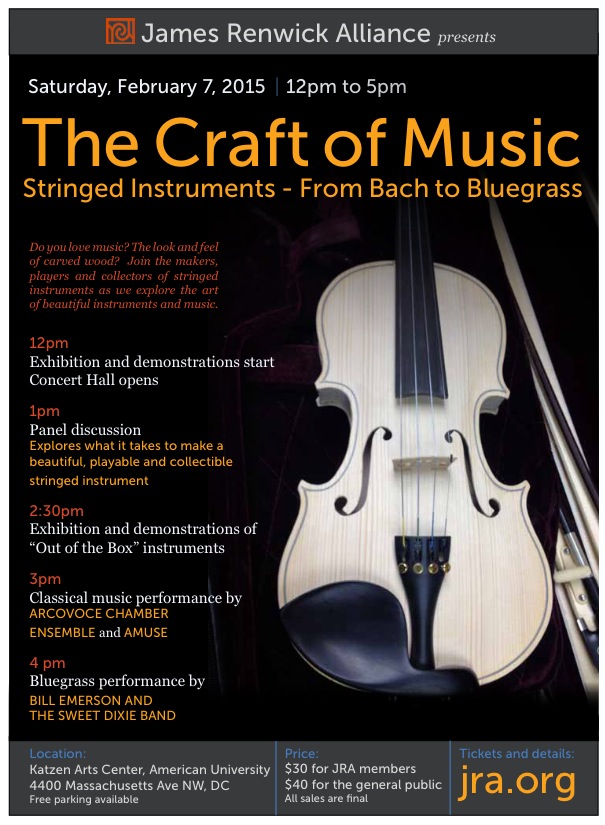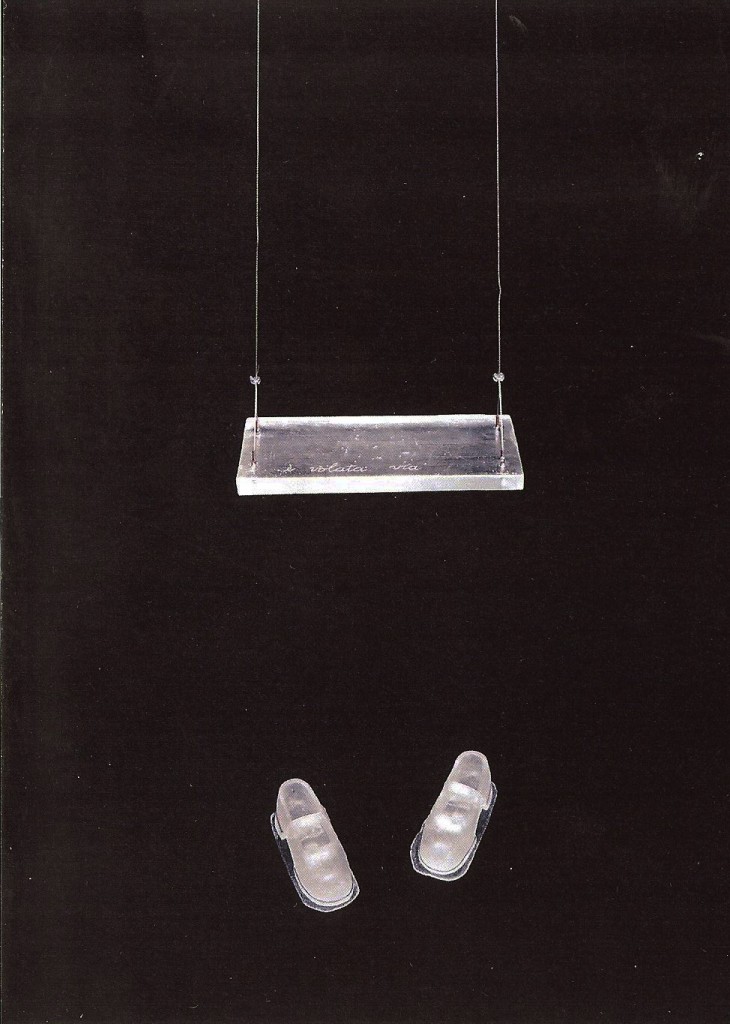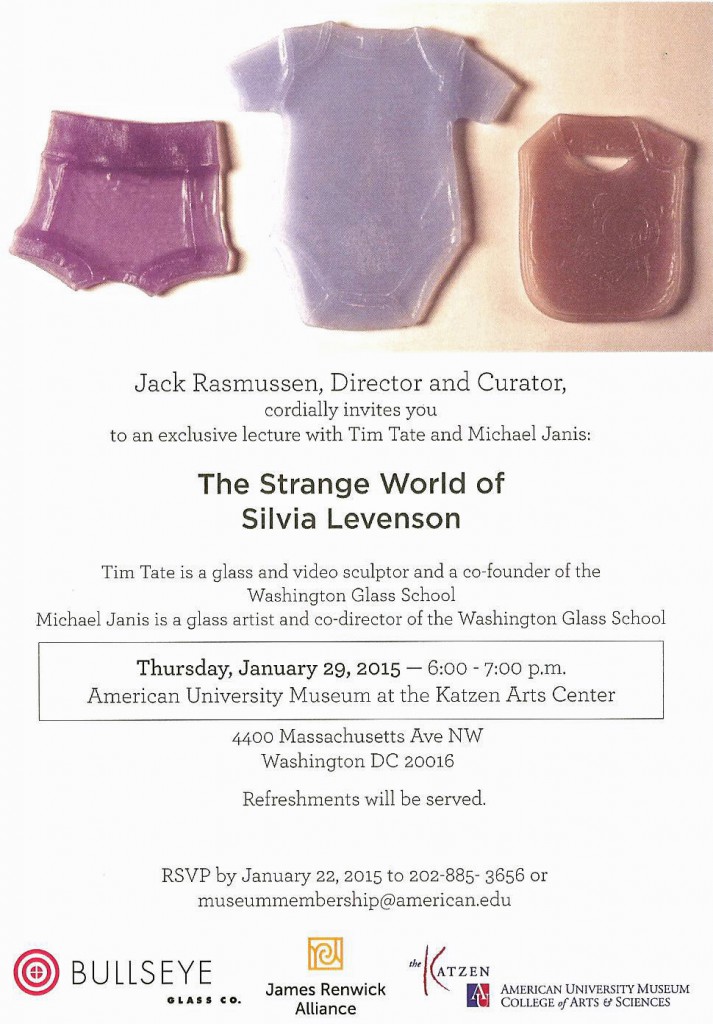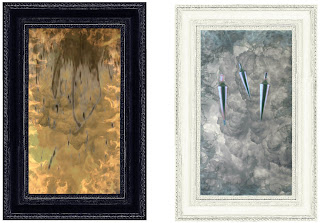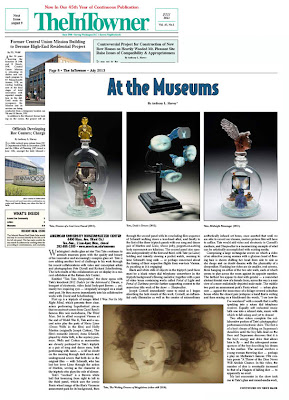 |
| The July issue of The InTowner features review by Tony Harvey |
The InTowner
Review of Tim Tate / Pete Duvall / Richard Schellenberg collaborative exhibition at American University Museum Pg 8, July, 2013
by Anthony Harvey
Washington’s studio glass art star Tim Tate continues to astonish museum goers with the quality and beauty of his innovative and increasingly complex glass art. Tate is now adding another level of challenge to his work through his recent collaborations with video and conceptual artists and photographers Pete Duvall and Richard Schellenberg. The rich results of this collaboration are on display in a current exhibition at the Katzen Arts Center.
Entitled “TimTate: Sleepwalker,” the show opens with Tate’s knockout 2012 Dada’s (or the Astronaut’s) Dream , a bouquet of electronic, video facial body-part flowers — primarily two inquiring eyes — irregularly arranged on a small steel post. He then moves immediately into his collaborative works with Duval and Schellenberg.
First up is a triptych of images titled: “I Was Not In My Right Mind”, which presents three characters performing hypothetical pieces that reconstruct scenes from Carol Reed’s famous film noir melodrama, The Third Man. Set in allied occupied Vienna at the end of World War II, Tate and a second actor play the parts of Harry Lime (Orson Wells in the film) and Holly Martins (originally Joseph Cotton). The film’s romantic interest, Anna Schmidt, played by Alida Valli, is the mystery presence. Wells and Cotton as marionettes are cleverly portrayed in Tate’s triptych as a pair of song and dance men, both performing with canes — a riff no doubt on the running through dark streets and underground sewers that both do in the original film — with Schmidt, who has lost her lover Lime through the action of Martins, serving as the character in the triptych who plays the role of silence.
Tate’s “rosebud” is a thrown white ball first bouncing from right to left in the third panel, which uses the iconic Ferris wheel image of the film’s Viennese amusement park for its background, then through the second panel with its concluding film sequence of Schmidt walking down a tree-lined alleé, and finally to the first of the three triptych panels with our song and dance pair of Martins and Lime, whose jerky, puppets-on-a-string body movements are hilarious. The second panel also operates independently of the first and third, with Tate (as Lime) holding and intently viewing a pocket watch, seeming to time Schmidt’s long walk — or perhaps concerned about the timing of their respective flights from war-torn Vienna. As puzzling as it is engaging!
Black and white stills of objects in the triptych (and there must be a black rotary dial telephone somewhere in the triptych background’s flowing narrative) together with a pair of video boxes containing works called Portal of Light and Portal of Darkness provide further supporting context to the marvelous title work of the show —Sleepwalker.
Joseph Cornell immediately came to mind as I began absorbing the lush visuals of this work. Cornell, an influential early filmmaker as well as the creator of extraordinary aesthetically infused art boxes, once asserted that until we are able to record our dreams, motion picture film will have to suffice. Tate would add video and electronic to Cornell’s medium, and Sleepwalker is a mesmerizing example of what can be artistically accomplished with existing media. Comprising a large rectangular screen on which a video of an attractive young woman with a glorious head of flowing hair is shown shifting her head from side to side as she sleeps and no doubt dreams with the physicality of a sleepwalker. Flanking her video are six smaller, oval screens, three hanging on either of the two side walls, each of which seems to play across the room against its opposite number. The farthest two appear to deal with gender — a somewhat abstract frontal view of a female form; across the way is a rear view of a more realistically depicted male nude. The middle two posit an amusement park’s Ferris wheel — urban pleasure — against the innocence of a foliage covered suburban house while the closest pair juxtapose a hand that is writing and then erasing on a blackboard the words, “I see how far I’ve wandered” with a mouth that is softly speaking into a rotary dial telephone receiver. Equally soft orchestral music lulls one into a relaxed state, music with which to fall asleep and yet to dream!
Two other videos complete the collaborative portion of Tate’s photographic/performance/electronic show. The first is of a boy’s dream of flying on Superman’s shoulders until the boy falls dead on the floor and Superman discovers that it is the boy’s energy and drive that allows him to fly — and the subsequent consequences of the boy describing his dream to his mother. The second involves a young woman throwing dice — perhaps a play on Mallarme’s famous 19th century poem “A Throw of the Dice Never Will Abolish Chance”. In this video, the number of dice is eventually increased to that of a Niagara of falling dice — to apparently no avail.My last encounter in the show took me to Tate’s glass and mixed-media work, specifically to a viewing of two of his terrific glass reliquaries. Both dramatically advance Tate’s multi-media creativity by incorporating miniature TV monitors playing poignant video narratives as the centerpieces of each of the reliquaries’ glass enclosed found, cast, and sculpted objects. The first of these, Dreams of a Lost Love Found, is especially engaging, with its character of a nude, sleeping boy depicted with a second figure — an apparition — rising from his bed and walking into the background only to return to the boy in the bed as a nude woman.
For the full newspaper pdf article – click HERE – starting Pg 8.
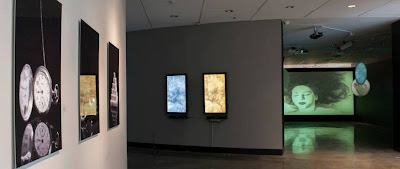 |
| photo by Pete Duvall |
“Tim Tate: Sleepwalker” continues through August 11th.
American University Museum/Katzen Center
4400 Mass. Ave.
Tue.-Sun., 11am-4pm; Mon., closed
202-885-1300 • www.american.edu/museum
